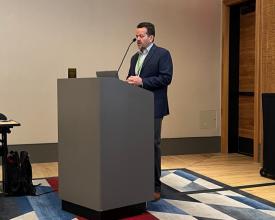DHA eNews - Buy America: Engineered Wood Must Be Made In U.S.
We know wood stores carbon and hardwood products reduce global warming potential. The Hardwood Federation recently advocated for these benefits to the U.S. Department of Agriculture, using DHA's recent Environmental Product Declaration for engineered wood floors to illustrate their point.
If you have questions or comments, contact me. I look forward to hearing from you.

Keith A. Christman, President
Decorative Hardwoods Association

The U.S. Office of Management and Budget has published its final guidance on the Build America, Buy America Act. Lumber and engineered wood were specifically included in the construction materials category—so, all manufacturing must take place in the U.S. to qualify. DHA has argued that hardwood plywood, veneer, and engineered wood flooring are manufactured products, but it's still unclear if they are considered "engineered wood."
In response to the Department of Agriculture's request for information related to greenhouse gas emissions, the Hardwood Federation—which includes DHA—emphasized the sustainability benefits of hardwood products, citing DHA's engineered wood flooring environmental product declaration that shows our floors reduce global warming potential by 80% compared to vinyl plank.
A new NASEM report backed the 2022 EPA review that found formaldehyde to be a human carcinogen. However, the American Chemistry Council has challenged several aspects of the report, including the validity of the toxicity values in the EPA's 2022 draft assessment, and stated that the report is not in line with international authorities like the World Health Organization and the European Chemicals Agency.
The EU's new deforestation law will pose significant challenges to companies exporting forest products to Europe. The essence of the law is that wood and wood products, among others, can't be connected with "forest removal or land change from forests into non-forests." Failure to comply with the new law may result in being banned from exporting to the EU market.
In June, U.S. imports of hardwood flooring fell by 15% vs. May, the second straight month of declines. Imports were also down by 3.5% vs. June 2022. Hardwood flooring imports from Brazil plunged by 60% in June to the lowest level since March 2020. Imports from China fell by 15%.
In June, U.S. imports of sawn tropical hardwoods reached their highest level of the year, up by 14% vs. May. Imports from Malaysia more than doubled. Canada saw an even stronger surge: imports grew by 78% in June after two months of declines.
Forecasters predict that the market for engineered wood will grow to more than $61 billion by the end of the year. This rapid growth is due to engineered wood's advantages over traditional solid wood, which include enhanced strength, stability, and sustainability. Engineered wood is cost‑effective as well as versatile and can be used in construction, furniture, flooring, and packaging.
The market for woodworking machinery is expected to grow to $4.86 billion this year and to $6.8 billion by 2030. The key drivers of growth are the increased adoption of automated woodworking machinery and more precise engineering in manufacturing.
Canada's Minister of Energy and Natural Resources has launched three programs designed to help support diversification, innovation, and competition in the country's forest sector. These programs are the Investment in the Forest Industry Transformation Program, Green Construction through Wood Program, and Canadian Wood Fiber Centre.
Capital Testing has published a FAQ that details when ASTM E162 flame spread testing—a measurement of surface flammability—is required and how it works. The test is specified in federal codes for manufactured home construction as well as codes for trains, buses, and RVs.
Amidst discussions on forests as climate change solutions, there is still loud opposition to tree cutting. However, recent public opinion polling shows a different side of understanding and beliefs about managed forests, wood products, and climate change. One result that may surprise you: 89% approve of managed forests.
A U.S. and Canadian research team is working to contain the spread of oak wilt. Once a tree contracts the disease, there is no way to save it. Oak wilt has been found in 24 states; the northern limit is in Michigan, Wisconsin, and Minnesota. Researchers are concerned that climate change will help push the disease past that U.S. border into Canada.
The destructive emerald ash borer, which has killed millions of ash trees across the U.S., was documented in North Carolina ten years ago. The beetle spread quickly throughout the state and is now in 60 of the 100 counties.
Researchers at the University of Minnesota Duluth just unveiled their latest innovation: a new kind of tree. Their cottonwood-poplar hybrid can grow up to eight feet per year. Scientists have produced more than 1,600 varieties of poplar, all fast-growing and disease-resistant, which may become part of the solution for climate change and help in soil and water cleanup.
What country has achieved the highest growth in forest area?





